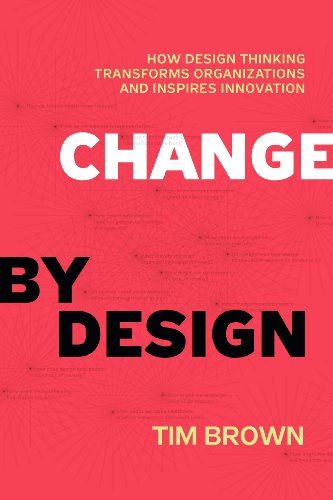Design icon and founder of the influential IDEO design firm, Tim Brown offers a practical workbook for new, inspiring methods of problem-solving and product implementation.

Design Thinking
Design Thinking
Many authors presenting new programs for enhanced productivity or problem-solving write with evangelical fervor. They offer to change your life, and they strive to gain your buy-in. Often, the level of their fervor proves a measure of the uselessness of their ideas. This never applies to Tim Brown. His approach to innovative thinking is quietly exciting and, at times, revelatory. His useful and applicable strategy for innovation draws its inspiration from design; his name for this process is “design thinking.”
Design thinking has its origins in the training and the professional practice of designers, but these are principles that can be practiced by everyone and extended to every field of activity.Tim Brown
Brown, CEO and president of IDEO, an influential design firm whose work sets an industry standard, is an icon in the design profession. He makes a convincing case that innovation is the norm at IDEO. The company expects employees not only to come up with new ideas – which, as Brown points out, are cheap and easy to generate in isolation – but to create new, workable solutions to real world problems. Brown’s tone, writing style and content expresses a passion for creation that never seems giddy or off-balance. Designers, those who manage designers, and anyone interested in innovation and creativity will savor his worthwhile, eye-opening methods.
The reviews of Brown’s approach are luminous. The New York Times said he “writes with a winning combination of thoughtfulness, pragmatism and enthusiasm.” Jacqueline Novogratz, founder of the Acumen Fund, said Brown’s “vision, intellect, empathy and humility shine through every page of this book…for dreamers and doers, for corporate executives and NGO leaders, for teachers, students and those interested in the art of innovation.”
“Human-centered exploration”
Brown’s theme is that society needs innovation that aligns the needs of human beings with the natural world. He maintains that design thinking, which springs from the ways designers conceptualize their work, provides that approach. Today, he argues, designers must apply design principles to consumer experiences, to production processes and interactions, and to making existing products more appealing or functional.
Brown breaks down the process into phases. In the inspiration phase, innovators consider a problem or opportunity. In ideation, they generate and test ideas. For implementation, they shift their innovation from discussion to an actual product. For each project, he assembles an interdisciplinary team and creates a brief stating the problem and the team’s goals for resolving it.
Brown repeatedly stresses that you can gain insight into how people actually use things only by carefully observing what they do or don’t do – and what they don’t or can’t explain about what they do. To this end, Brown advises adding designers or engineers to your team. He argues for reworking your incentive system and developing metrics for the innovation you seek.
Prototypes
Brown provides shortcuts to IDEO’s hard-won wisdom: don’t create ideas in isolation, in the abstract or with words alone. To develop ideas faster, use multiple methods, such as prototypes and drawings.
We are in the midst of a significant change in how we think about the role of consumers in the process of design and development.Tim Brown
Brown explains that early models of products should have only enough detail to test their viability. He suggests acting out scenarios using imagined devices. This section proves frustrating; Brown doesn’t provide sufficient detail about constitutes a prototype. Perhaps he’s so immersed in his method he can’t imagine a beginner’s confusion.
Brown says often that innovation must address users’ experience and emotional response. He recommends picturing yourself in the users’ place and trying to feel what they feel. He says you should empathize with the emotions consumers feel at three stages: when they search for your offering, when they purchase it and when they use it.
Brown delivers a strong practical message that all businesses must become more service-oriented and offer a stronger customer experience. As the distinction between products and services blurs, so does the distinction between consumer and producer. Brown cites Wikipedia as an example: people use it as they participate in creating it.
Purpose
Brown addresses the changing context of innovation. He believes firms should design not only for local customers and profit, but also to meet the needs of their communities and to make the world a better place.
The transformation of a business-as-usual culture into one focused on innovation and driven by design involves activities, decisions and attitudes.Tim Brown
As you create new possibilities, he urges you to address present environmental realities. He wants every business to recognize the interwoven nature of the economy and environment and to embrace an inspiring constraint: “doing more with less.”
Visionary Common Sense
Brown’s explanations are unusually clear and grounded in common sense. His advice is functional, in no small part, because IDEO has accomplished so much that many of his suggestions might ring familiar to those in the field, practitioners who know IDEO’s techniques. Brown’s approach will not seem esoteric to anyone in a creative position, and yet it remains accessible to those in more traditional businesses who may not habitually apply Brown’s intuitive logic to problem-solving. His methodical, socially aware approach is engaging, inspirational and entirely actionable.
Other worthwhile reads on design and radical solution-finding include IDEO.org’s The Field Guide to Human-Centered Design, Jake Knapp’s Sprint: How to Solve Big Problems and Test New Ideas in Just Five Days, and Michael Lewrick, Patrick Link and Larry Leifer’s The Design Thinking Toolbox: How to Solve Big Problems and Test New Ideas in Just Five Days. In the same series, also consider the three authors’ The Design Thinking Playbook: Mindful Digital Transformation of Teams, Products, Services, Businesses and Ecosystems, as well as The Design Thinking Life Playbook: Empower Yourself, Embrace Change, and Visualize a Joyful Life by Lewrick, Link and Jean-Paul Thommen.





